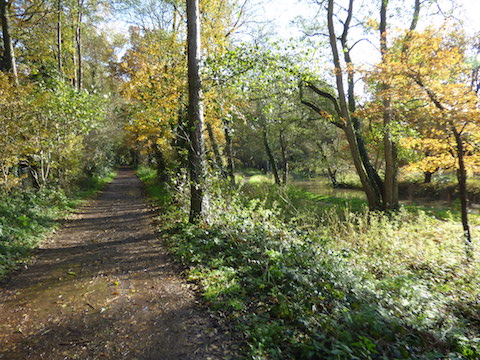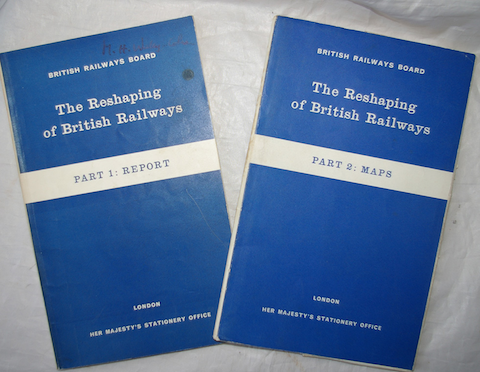 Abraham Lincoln
If given the truth, the people can be depended upon to meet any national crisis...
Abraham Lincoln
If given the truth, the people can be depended upon to meet any national crisis...
 Guildford news...
for Guildford people, brought to you by Guildford reporters - Guildford's own news service
Guildford news...
for Guildford people, brought to you by Guildford reporters - Guildford's own news service
Letter: No Room On Parts Of Downs Link Path For Canal And Railway
Published on: 21 Nov, 2020
Updated on: 21 Nov, 2020
 From Frank Phillipson
From Frank Phillipson
The statement [from the Wey & Arun Canal Trust] that “the canal and railway plans are not incompatible” and “the canal plans will not prevent re-establishment of the railway” are incorrect.
In some locations within the former railway corridor there is only room for the canal and towpath / Downs Link path and the only way a new railway could be accommodated would be if it was to run on a deck above and along the proposed canal!

The Downs Link path looking towards Bramley with the Cranleigh Waters stream to the right.
If the railway was re-established it would not be difficult to retain the Downs Link path as mostly there is room to run a path and railway line alongside one another with suitable fencing.
At pinch points the path could be diverted to run higher or lower along the railway cuttings or embankments or by other short diversions that would not be unreasonable for a footpath.
With encouragement from recent Government initiatives, reinstatement of the line compared with some other contemporary reinstatement projects, could be achieved at moderate cost given the largely existing earthworks.
Significant engineering work would be needed to construct a new bridge over the A281 at Shalford, but there is room there for such a bridge and its approaches to be constructed using some of the old road alignment without the need to close off the present road until its traffic could be transferred to the new bridge.
Other bridge replacements seem relatively straight forward and the construction of a new Cranleigh station could be located just short of the old station site or in the field south of the line opposite St James’s Place with access through Stocklund Square’s car park.
The station would only need to consist of a single line and platform.

Demolition of Cranleigh station after the closeure of the line in 1965. Picture Dave Salmon, Geoff Burch Collection.
Do we put leisure and amenity of the canal above what could be an essential part of the local transport infrastructure, which could relieve the current A281’s horrendous traffic congestion and harmful environmental effects that will only get worse with the feverish housing sprouting up all around Cranleigh as well as the development at Dunsfold airfield and Alfold?

The two reports that led to the closure of many branch lines in the 1960s including the Guildford to Horsham line.
Some further information on re-opening of railways: List of Beeching Cut Railway Services that have Since Reopened and Further Planned Proposals (6 Pages).
There have been Department for Transport announcements on restoring railways in November 2017, December 2018, January 2020 April 2020 and May 2020.
The Financial Times, 2020: “Reversing Beeching cuts now has top-level political priority; it chimes with Boris Johnson’s pledge that it will invest in ‘left behind’ communities to level up the UK economy.”
Responses to Letter: No Room On Parts Of Downs Link Path For Canal And Railway
Leave a Comment Cancel reply
Please see our comments policy. All comments are moderated and may take time to appear. Full names, or at least initial and surname, must be given.
Click on cartoon for Dragon story: Public Asked for Views on SCC’s Proposal for Reduced Speed Limits






Recent Articles
- Eight Out of Ten PIP Claimants in Guildford Face Cuts to Their “Lifeline”
- Waverley’s New Discretionary CIL Review Scheme To Be Revealed Soon
- Council Accepts Responsibility of Meeting Farnham Museum’s Ballooning Repair Costs
- Notice: Cut It Out!
- Stoke Park Was Bought 100 Years Ago with Plans for a Public Open Space and Houses!
- Dragon Review: The Pajama Game – Yvonne Arnaud Theatre
- A Hidden Gem in the Hills: Michelin-Backed William IV Pub Brings Refined Dining to Albury
- Letter: Help Reduce Speeding By Joining a Community Speedwatch Team
- Hospital Apologises ‘Unreservedly’ After Death of Disabled Girl
- Birdwatcher’s Diary No.328


Recent Comments
- Bernard Quoroll on Community Councils Proposed to Maintain Local Representation
- John Lomas on A Look Back at Perry Hill’s New Inn and a Family That Once Ran It
- Robert Garbolinski on Dragon Review: The Pajama Game – Yvonne Arnaud Theatre
- Philip Camp on A Look Back at Perry Hill’s New Inn and a Family That Once Ran It
- RWL Davies on Community Councils Proposed to Maintain Local Representation
- Stephen Spark on Major Disruption on the Railway During Hot Day in 1900
Search in Site
Media Gallery
Dragon Interview: Local Artist Leaves Her Mark At One of England’s Most Historic Buildings
January 21, 2023 / No Comment / Read MoreDragon Interview: Lib Dem Planning Chair: ‘Current Policy Doesn’t Work for Local People’
January 19, 2023 / No Comment / Read MoreA3 Tunnel in Guildford ‘Necessary’ for New Homes, Says Guildford’s MP
January 10, 2023 / No Comment / Read More‘Madness’ for London Road Scheme to Go Ahead Against ‘Huge Opposition’, Says SCC Leader
January 6, 2023 / No Comment / Read MoreCouncillor’s Son Starts Campaign for More Consultation on North Street Plan
December 30, 2022 / No Comment / Read MoreCounty Council Climbs Down Over London Road Works – Further ‘Engagement’ Period Announced
December 14, 2022 / No Comment / Read MoreDragon Interview: GBC Reaction to the Government’s Expected Decision to Relax Housing Targets
December 7, 2022 / No Comment / Read MoreHow Can Our Town Centre Businesses Recover? Watch the Shop Front Debate
May 18, 2020 / No Comment / Read More






Martin Elliott
November 21, 2020 at 10:42 am
Statements of the feasibility of a powered transport link and the Downs Way are no more substantiated by real engineering information than the Canal Trust claims.
On the other hand, the Canal Trust will have to cover its own financials for a canal.
I don’t remember any studies for re-building a powered transport link that gave verifiable capital costs of such a project or demonstrated at least a break-even/no subsidy running of a link by passenger demand.
Remember this route was closed by Dr Beeching’s report because it wasn’t able to break even in the 1960s.
Paul Robinson
November 21, 2020 at 12:37 pm
I believe in producing the justification for line closure the books were cooked by such means as billing track/bridge maintenance in one financial year rather than spreading the cost over the years before that work had to be repeated.
The line was also closed just before the large Cranleigh housing developments were started. I suspect those new houses would have altered the operating costs of the line into a going concern as would making the stations unmanned.
Paul Robinson
November 25, 2020 at 7:15 pm
Further to my earlier reply, I have since found a book on my bookshelf called ‘The Great Railway Conspiracy’ by David Henshaw published in 1991.
It quotes the Railway Development Society as saying the population growth along the Cranleigh – Guildford line between 1961 & 1981 was +72%.
H.Trevor Jones
November 21, 2020 at 12:02 pm
Here for info is the Guildford rail users letter of objection:
To Waverley Borough Council
By email to consultation.planning@waverley.gov.uk
18 October 2020
The Guildford rail users (Gru) strongly object to the proposals by the Wey and Arun Canal to take part of the trackbed of the currently disused Guildford – Cranleigh – Horsham railway somewhere in the vicinity of Bramley for the purpose of reinstating the canal, as that might forever preclude reinstatement of the railway.
This objection is because we believe that there will in due course, whether sooner or later, become a business case for reinstating the railway at least between Guildford and Cranleigh for the purpose of relieving the current road congestion and slow bus service between the two towns and possibly also for the purpose of serving any major housing development at Dunsfold, although that would need an extra branch off the former railway. We would not wish all this to become precluded by one little bit of canal, especially when historically the canal existed separately at the same time as the railway and could presumably be made to do so again, albeit at greater cost.
Also looking further ahead, given the growing concerns over climate change due to carbon usage, in particular that generated by road traffic, we see the possibility that a Guildford – Cranleigh – Horsham railway in conjunction with a reinstated Horsham – Shoreham railway and a new spur at West Horsham could form part of a strategic rail link between the West Midlands, Reading and the port of Shoreham for freight and Brighton for inter-city passenger traffic, so reducing the need for road traffic but also avoiding use of the congested London – Brighton mainline railway.
Yours sincerely…
H, Trevor Jones
Guildford rail users (Gru) Coordinator
Guildford rail users (Gru) is basically an email list of about 40 people most of whom are known personally to its Coordinator, many of whom are or were local politicians or leaders of other environmental organisations. When there are consultations or conferences or other issues coming up, then the group is consulted before responding or anyone attending on behalf of Gru (at the individual’s expense as the group is unfunded). We are generally more interested in strategic future planning and policy matters rather than in the run-of-the-mill day-to-day operations of punctuality and reliability. We are independent of any other voluntary or other body although we liaise with several others, some of which the Coordinator is separately a member in his own personal right.
Ben Paton
November 21, 2020 at 12:15 pm
Dr Beeching was shortsighted in not protecting the routes for future and alternative uses. The population has grown significantly since. Dunsfold New Town will be a source of added demand. And the position sixty years ago may not be relevant today.